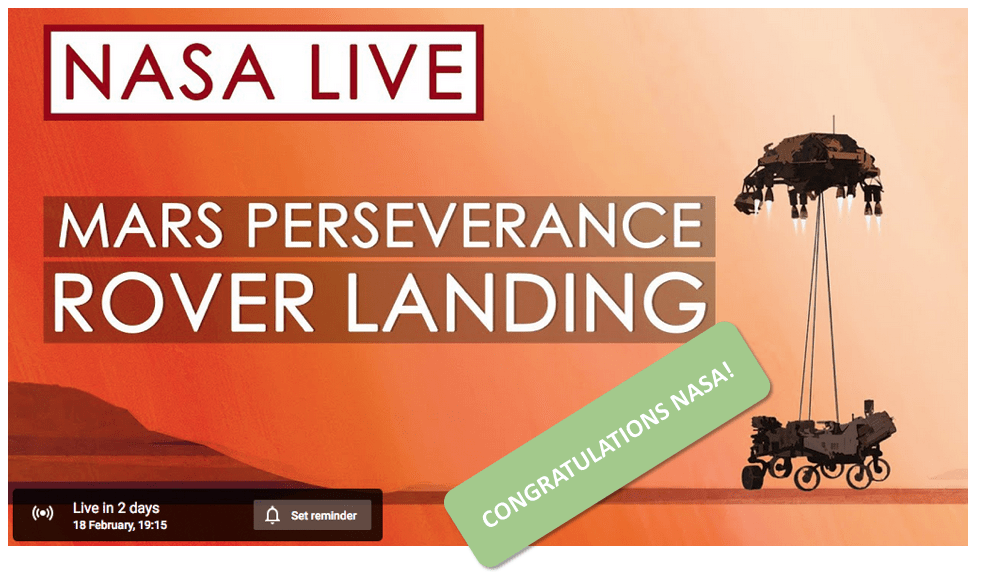Incredible science
Whilst not strictly related to email marketing, we can’t help but get excited by the upcoming NASA Mars mission and the amazing science that has gone into it.
On the 18th February 2021, The NASA rover Perseverance will start its “Seven minutes of hell”, as it descends to the surface of Mars (see video below). There is unprecedented public access for the landing and the mission itself. The descent itself will be streamed live across many platforms, including YouTube, which you can find here.
A lot is riding on the success of this mission, which aims to establish the conditions for future Mars exploration, including humans. A helicopter “Ingenuity” is also part of the mission, as a technology demonstrator.
Perseverance’s mobile science laboratory
Perseverance is a self powered, remote, mobile science laboratory with some incredible capabilities:
Mastcam-Z
Mastcam-Z is a multispectral, stereoscopic imaging instrument based on the Mastcam instrument that operated on NASA’s Mars Curiosity rover.
Mars Environmental Dynamics Analyzer (MEDA)
MEDA is a suite of environmental sensors designed to record dust optical properties and six atmospheric parameters: wind speed/direction, pressure, relative humidity, air temperature, ground temperature, and radiation in discrete bands of the UV, visible, and IR ranges of the spectrum.
Mars Oxygen ISRU Experiment (MOXIE)
MOXIE collects CO2 from the Martian atmosphere, then electrochemically splits the CO2 molecules into O2 and CO. The O2 is then analyzed for purity before being vented back out to the Mars atmosphere along with the CO and other exhaust products.
Planetary Instrument for X-ray Lithochemistry (PIXL)
The PIXL is a microfocus X-ray fluorescence instrument that rapidly measures elemental chemistry at sub-millimeter scales by focusing an X-ray beam to a tiny spot on the target rock or soil and analyzing the induced X-ray fluorescence. The PIXL can detect elements: Na, Mg, Al, Si, P, S, Cl, K, Ca, Ti, V, Cr, Mn, Fe, Co, Ni, Cu, Zn, Br, Rb, Sr, Y, Ga, Ge, As, and Zr, with important trace elements such as Rb, Sr, Y and Zr detectable at 10’s ppm level.
Radar Imager for Mars’ Subsurface Experiment (RIMFAX)
RIMFAX builds on mature tried-and-true ground-penetrating radar (GPR) technology used on Earth for a wide variety of scientific and engineering applications, adapted for use in a rover platform on the surface of Mars. Its ultra wideband design, operating from 150 MHz to 1.2 GHz, affords a theoretical limit of 14.2 cm for vertical (range) resolution in free-space.
Scanning Habitable Environments with Raman & Luminescence for Organics & Chemicals (SHERLOC)
SHERLOC is an arm-mounted, Deep UV (DUV) resonance Raman and fluorescence spectrometer utilizing a 248.6-nm DUV laser and <100 micron spot size. The laser is integrated to an autofocusing/scanning optical system, and co-boresighted to a context imager with a spatial resolution of 30 µm.
SuperCam
SuperCam is, in fact, many instruments in one.
- For measurements of elemental composition, it integrates remote Laser Induced Breakdown Spectroscopy (LIBS). LIBS uses a 1064-nm laser to investigate targets up to 7 m from the rover.
- SuperCam also performs Raman spectroscopy (at 532 nm to investigate targets up to 12 m from the rover), Time-Resolved Fluorescence (TRF) spectroscopy, Visible and InfraRed (VISIR) reflectance spectroscopy (400 – 900 nm, 1.3 – 2.6 µm) at a distance in order to provide information about the mineralogy and molecular structure of samples.
- SuperCam also acquires high-resolution images of samples under study using a color remote micro-imager (RMI).
The collection of data provided by this suite of correlated measurements on a sample can be used to determine directly the geochemistry and mineralogy of samples.
Don’t forget to tune in on the 18th February!

